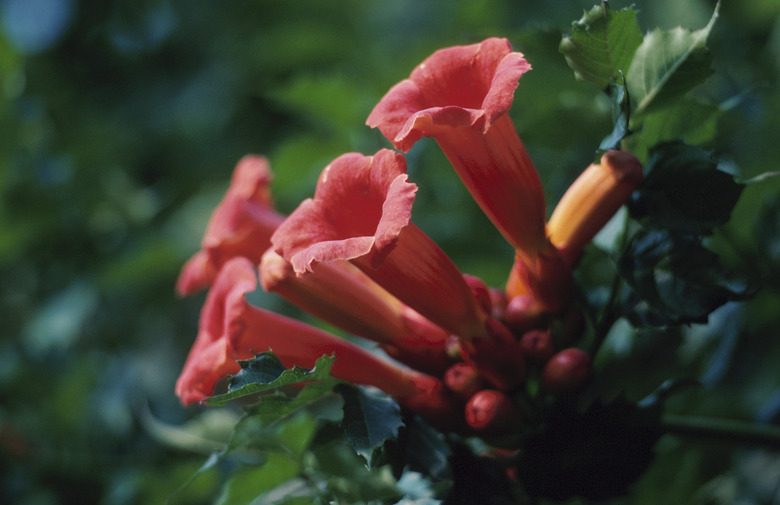Flowering Vines That Grow Wild In Alabama
As with many of the southeastern states, the state of Alabama generally lies within a subtropical humid climate zone, largely influenced by the Gulf of Mexico. This warm, moist environment makes Alabama conducive for the growth of a lush array of native wildflowers, including some flowering vines that grow naturally in the wild.
Step 1
Native to many of the eastern states, the trumpet creeper is an aggressive vine that spreads and clings to almost anything, able to climb as high as 35 feet. During the summer months, it produces large clusters of attractive, trumpet-shaped orange-red blossoms that hummingbirds often find irresistible. This species is perennial, drought-hardy, colonizes rapidly and can be quite invasive, especially in the South. The best place to spot trumpet creeper in the wild is when it is climbing on tree trunks that see plenty of sun.
Wright's Morning Glory (Ipomoea wrightii)
Step 1
Sometimes called palmleaf morning glory because of the palmate shape of its leaves, this flowering vine can climb or trail along the ground, each individual plant capable of reaching about 6 feet long. The purplish flowers along the vine open in the early mornings beginning in mid-summer, and wilt during the heat of the day. This species occurs naturally in the southern thickets and along roadsides, and although it is not as prolific as other flowering vines, it is considered a weed because of its invasive nature.
Step 2
- Native to many of the eastern states, the trumpet creeper is an aggressive vine that spreads and clings to almost anything, able to climb as high as 35 feet.
- Sometimes called palmleaf morning glory because of the palmate shape of its leaves, this flowering vine can climb or trail along the ground, each individual plant capable of reaching about 6 feet long.
American Wisteria (Wisteria frutescens)
Step 1
Another perennial vine common to the southern states, this leafy plant is also a high climber capable of growing to around 30 feet. Its aromatic blossoms are lavender or white, occurring in late spring in clusters reminiscent of lilacs. This vine prefers a moist soil and is most likely to be found in wet, wooded areas or near rivers. American wisteria is an attractive flowering vine that is considered less aggressive than other vines found in the wild.
Yellow Jessamine (Gelsemium sempervirens)
Step 1
This perennial vine is best known for its abundant and attractive display of yellow flowers which begin blooming in early spring. Occurring naturally in thickets and open wooded areas throughout Alabama and other southeastern states, it tends to trail along the ground in full sun, but in shaded areas will climb and twine aggressively up to 20 feet to find the sunshine. Yellow jessamine is an evergreen woody vine retaining its leaves year-round. Its blossom is also the state flower of South Carolina.
Step 2
- Another perennial vine common to the southern states, this leafy plant is also a high climber capable of growing to around 30 feet.
- American wisteria is an attractive flowering vine that is considered less aggressive than other vines found in the wild.
